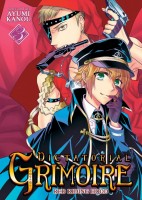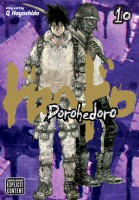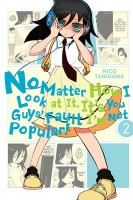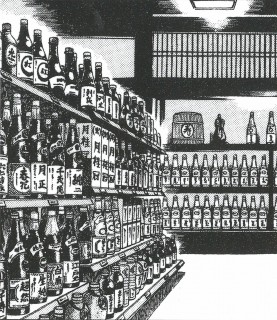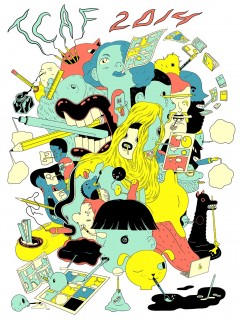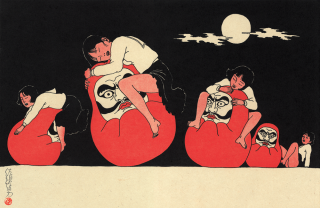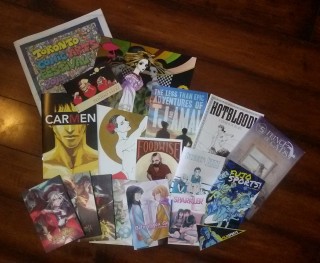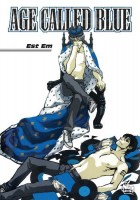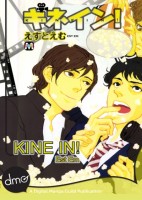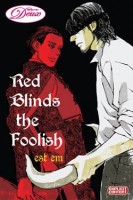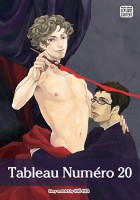Not counting the big box of review copies that arrived at the very end of the month, May actually has the distinction of my comics acquisitions outnumbering my manga acquisitions for the month. This is partly due to the fact that I went to TCAF and came away with a lot of goodies. This included picking up the first volume of Hotblood!: A Centaur in the Old West by Toril Orlesky, which is one of my new favorite things, as well as est em’s doujinshi Carmen among many others. As for the preorders that I was particularly excited to receive in May: the third-to-last volume of Blade of the Immortal and the second volume of What Did You Eat Yesterday? were released (reviews to come very soon), as was the second volume of Gangsta, which is a series I’m really looking forward to reading more of. It wasn’t exactly a preorder, but Massive also recently released Caveman Guu by Jiraiya. It’s only sixteen pages, but it’s pretty great. (Caveman Guu will actually be included in Massive: Gay Erotic Manga and the Men Who Make It from Fantagraphics later this year, too.)
Manga!
Android Angels by Kosuke Kabaya
Attack on Titan: No Regrets, Volume 1 written by Gun Snark, illustrated by Hikaru Suruga
Blade of the Immortal, Volume 29: Beyond Good and Evil by Hiroaki Samura
Carmen by est em
Caveman Guu by Jiraiya
Clan of the Nakagamis, Volumes 1-2 by Homerun Ken
Devils and Realist, Volume 1 written by Madoka Takadono, illustrated by Utako Yukihiro
An Even More Beautiful Lie by Kei Kanai
Fairy Tail, Volume 38 by Hiro Mashima
Gangsta, Volume 2 by Kohske
Hard Rock by Akane Abe
Haunted House by Mitsukazu Mihara
Hetalia: Axis Powers, Volume 6 by Himaruya Hidekaz
Kine In! by est em
Monster Musume, Volume 3 by Okayado
Monster Soul, Volume 1 by Hiro Mashima
My Little Monster, Volume 2 by Robico
No. 6, Volume 7 by Hinoki Kino
Otomen, Volume 18 by Aya Kanno
Palepoli by Usamaru Furuya
Sankarea: Undying Love, Volume 7 by Mitsuru Hattori
Say I Love You, Volume 2 by Kanae Hazuki
The Seven Deadly Sins, Volume 2 by Nakaba Suzuki
Sherlock Bones, Volume 5 written by Yuma Ando, illustrated by Yuki Sato
Ultras by est em
What Did You Eat Yesterday?, Volume 2 by Fumi Yoshinaga
A Wish of My Sister by Masahiro Itosugi
Comics!
All You Need is Kill adapted by Nick Mamatas, illustrated by Lee Ferguson
Andre the Giant: Life and Legend by Box Brown
Before You Go by Denise Schroeder
By Chance or Providence by Becky Cloonan
Carciphona, Volumes 1-4 by Shilin Huang
Dinner Ditz by Alexis Cooke
Erogenous by Creative Alchemy
Finn and Charlie Are Hitched, Volume 4: Everyone Is Someone’s Fetish by Tony Breed
Foodwise by Tony Breed
Fujosports! by Various
Hotblood!: A Centaur in the Old West, Volume 1 by Toril Orlesky
The Less Than Epic Adventures of TJ and Amal, Volume 3: Ten Days of Perfect Tunes by E. K. Weaver
My New Fighting Technique is Unstoppable by David Rees
Oafanthology: A Collection of Wuvable Oaf Drawings & Stories edited by Ed Luce
This One Summer written by Mariko Tamaki, illustrated by Jillian Tamaki
The True Lives of the Fabulous Killjoys written by Gerard Way and Shaun Simon, illustrated by Becky Cloonan
Yuri Monogatari, Volume 2 by Various
Novels!
Malice by Keigo Higashino
You and the Pirates by Jocelyne Allen
Collections!
Akiba Anime Art Magazine, Volume 00
Granta: The Magazine of New Writing, Issue 127: Japan
Anime!
Yukikaze, Volumes 1-3 directed by Masahiko Ōkura
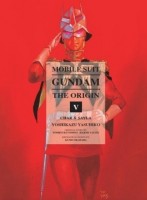






 MICHELLE: Oh, jeez. Do I pick Goong, whose virtues I have extolled in the past, or
MICHELLE: Oh, jeez. Do I pick Goong, whose virtues I have extolled in the past, or 
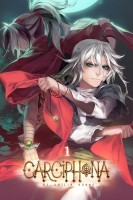
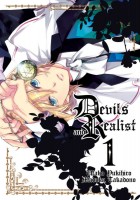
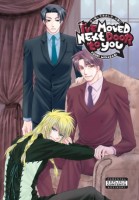






 SEAN: My pick of the Week is definitely the 10th volume of DMP’s
SEAN: My pick of the Week is definitely the 10th volume of DMP’s 